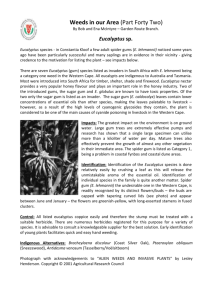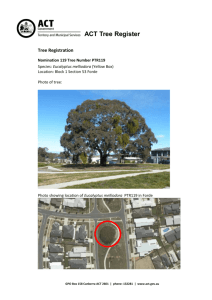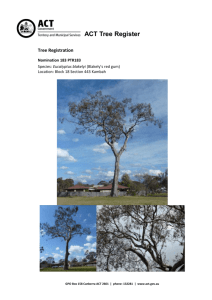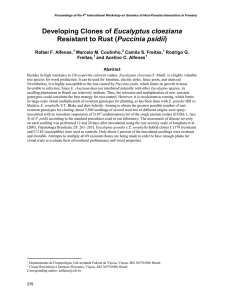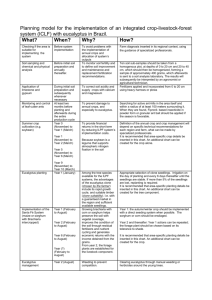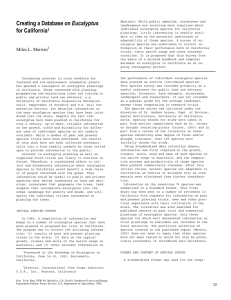Document 11236026
advertisement
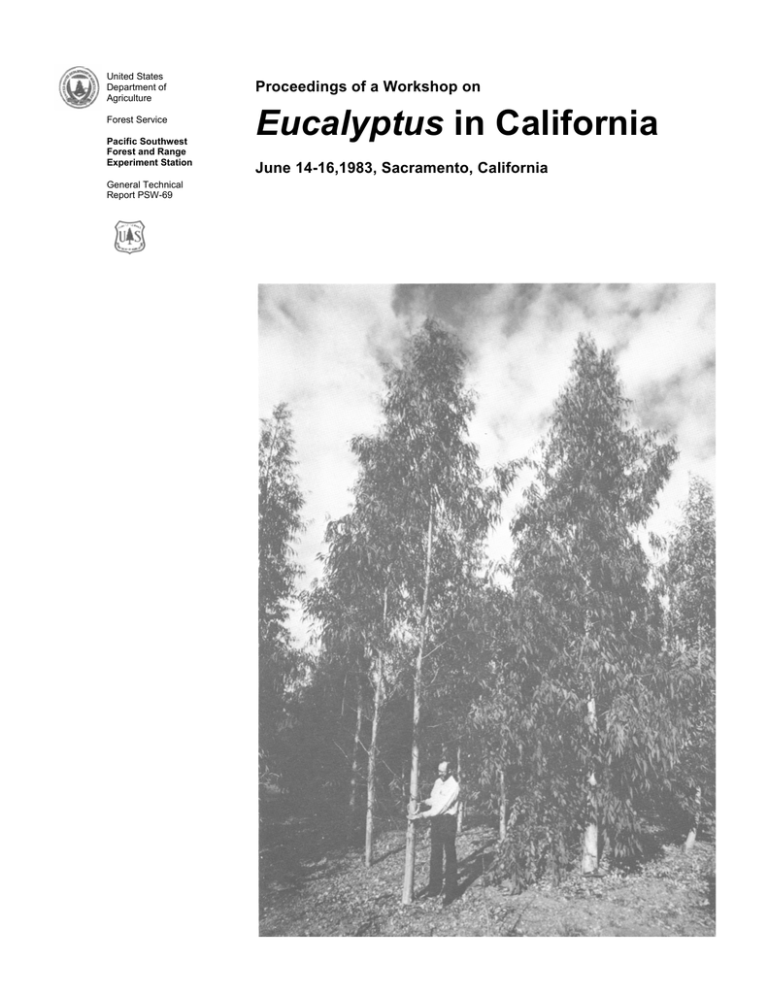
United States Department of Agriculture Proceedings of a Workshop on Forest Service Eucalyptus in California Pacific Southwest Forest and Range Experiment Station General Technical Report PSW-69 June 14-16,1983, Sacramento, California Cover: A stand of 50-month-old Eucalyptus camaldulensis growing in Calistoga, California. Average height of the trees is 6.7 m and average diameter-at-breast-height (d.b.h.) is 7.9 cm. Publisher Pacific Southwest Forest and Range Experiment Station P.O. Box 245, Berkeley, California 94701 October 1983 Standiford, Richard B; Ledig, F Thomas, technical coordinators. Proceedings of a workshop on Eucalyptus in California, June 14-16, 1983, Sacramento, California. Gen. Tech. Rep. PSW 69. Berkeley, CA: Pacific Southwest Forest and Range Experiment Station, Forest Service, U.S. Department of Agriculture; 1983. 128 p. To provide up-to-date information on Eucalyptus in California, researchers from California, Florida, Hawaii, Oregon, and France presented papers on species selection, products, uses, and economics, growth and yield, cultural requirements, propagation, and breeding programs. This Proceedings of the Workshop should serve as a useful reference for landowners, foresters, nurserymen, horticulturists, and others who are planning to plant Eucalyptus. Retrieval Terms: Eucalyptus, short-rotation trees, biomass, wood energy Proceedings of a Workshop on Eucalyptus in California June 14-16, 1983, Sacramento, California Technical Coordinators: Richard B. Standiford Cooperative Extension University of California F. Thomas Ledig Pacific Southwest Forest and Range Experiment Station CONTENTS PART 1. HISTORY OF EUCALYPTS IN CALIFORNIA Eucalyptus Helped Solve a Timber Problem: 1853-1880 Gayle M. Groenendaal.............................................................1 PART 2. SPECIES SELECTION Adaptability of Some Eucalyptus Species in Southwest Oregon Lee O. Hunt .........................................................................9 Southern California Trial Plantings of Eucalyptus Paul W. Moore ..................................................................14 Soil Conservation Service Tests of Eucalyptus Species for Windbreaks Gary L. Young ...................................................................18 Eucalyptus as a Landscape Tree W. Douglas Hamilton ........................................................22 Creating a Database on Eucalyptus for California Miles L. Merwin .................................................................25 PART 3. PRODUCTS, USES, ECONOMICS Using Eucalypts in Manufacturing William A. Dost .................................................................30 California Wood Energy Program Gary Brittner .....................................................................33 Large-Scale Eucalyptus Energy Farms and Power Cogeneration Robert C. Noroña ..............................................................35 Economic Evaluation of Eucalypt Energy Plantations Richard B. Standiford and F. Thomas Ledig .....................42 PART 4. GROWTH AND YIELD Growth and Yield of Some Eucalypts of Interest to California Roger G. Skolmen ............................................................. 49 Evaluating Trees as Energy Crops in Napa County Dean R. Donaldson and Richard B. Standiford ................ 58 Growth and Yield in Eucalyptus globulus James A. Rinehart and Richard B. Standiford .................. 61 Industrial Planting of E. viminalis in Mendocino County Peter C. Passof and John W. Sweeley ............................... 69 Yields in High Density, Short Rotation Intensive Culture (SRIC) —Plantations of Eucalyptus and Other Hardwood Species R.M. Sachs and C.B. Low .................................................. 71 PART 5. CULTURAL REQUIREMENTS Vegetation Management in Eucalyptus Clyde L. Elmore ................................................................ 76 Spacing Trials Using the Nelder Wheel Walter B. Mark .................................................................. 81 Establishing a Eucalyptus Energy Plantation on the Central Coast of California Norman H. Pillsbury and Nelson L. Ayers ........................ 86 Fertilization and Irrigation of Eucalyptus in Southern California Paul W. Moore .................................................................. 90 Managing a Coastal Bluegum ( Eucalyptus globulus) Forest Ralph S. Osterling ............................................................. 93 Harvesting to Get a Eucalyptus Coppice Crop Thomas F Geary ................................................................95 Clonal Propagation of Eucalyptus by Cuttings in France H. Chaperon .................................................................... 108 PART 6. PROPAGATION Propagation and Planting of Containerized Eucalyptus Seedlings in Hawaii Gerald A. Walters ..............................................................98 Micropropagation of Frost-Resistant Eucalyptus Michel Boulay ..................................................................102 PART 7. BREEDING PROGRAMS Eucalypt Improvement for California: Progress and Plans F. Thomas Ledig ............................................................. 115 Realized Gain from Breeding Eucalyptus grandis in Florida George Meskimen ........................................................... 121 PREFACE Although eucalypts (genus Eucalyptus) were introduced into California more than 125 years ago, little has been done to provide systematic programs for identifying superior planting stock. Eucalypts have long been considered landscape trees but are now in demand because of their potential for shortrotation fuel biomass production. Growers need a reliable source of rapidly growing planting stock. To provide information for that purpose, species and provenance tests have been and are being conducted. To bring together researchers working with eucalypts to define the state of our knowledge about the genus, "A Workshop on Eucalyptus in California" was held June 14 to 16, 1983, in Sacramento, California. It was sponsored by the Pacific Southwest Forest and Range Experiment Station, Forest Service, U.S. Department of Agriculture, Berkeley, California, and Cooperative Extension, University of California, Berkeley, California. Speakers from California, Florida, Hawaii, Oregon, and France presented information about advanced breeding programs and discussed how their results and methods could be applied in California. Major topics included species selection, products, uses, and economics, growth and yield, cultural requirements, breeding programs, and propagation. To expedite the publication of the Proceedings, we asked each author to assume full responsibility for submitting manuscripts in photoready format by the time the conference convened. The views expressed in each paper are those of the author and not necessarily those of the sponsoring organizations. Trade names are used solely for necessary information and do not imply endorsement by sponsoring organizations. These Proceedings will serve as a useful reference for landowners, foresters, nurserymen, and horticulturists who are considering planting species of this versatile and useful genus—the Eucalyptus. Technical Coordinators: Richard B. Standiford Cooperative Extension, University of California F. Thomas Ledig Pacific Southwest Forest and Range Experiment Station
